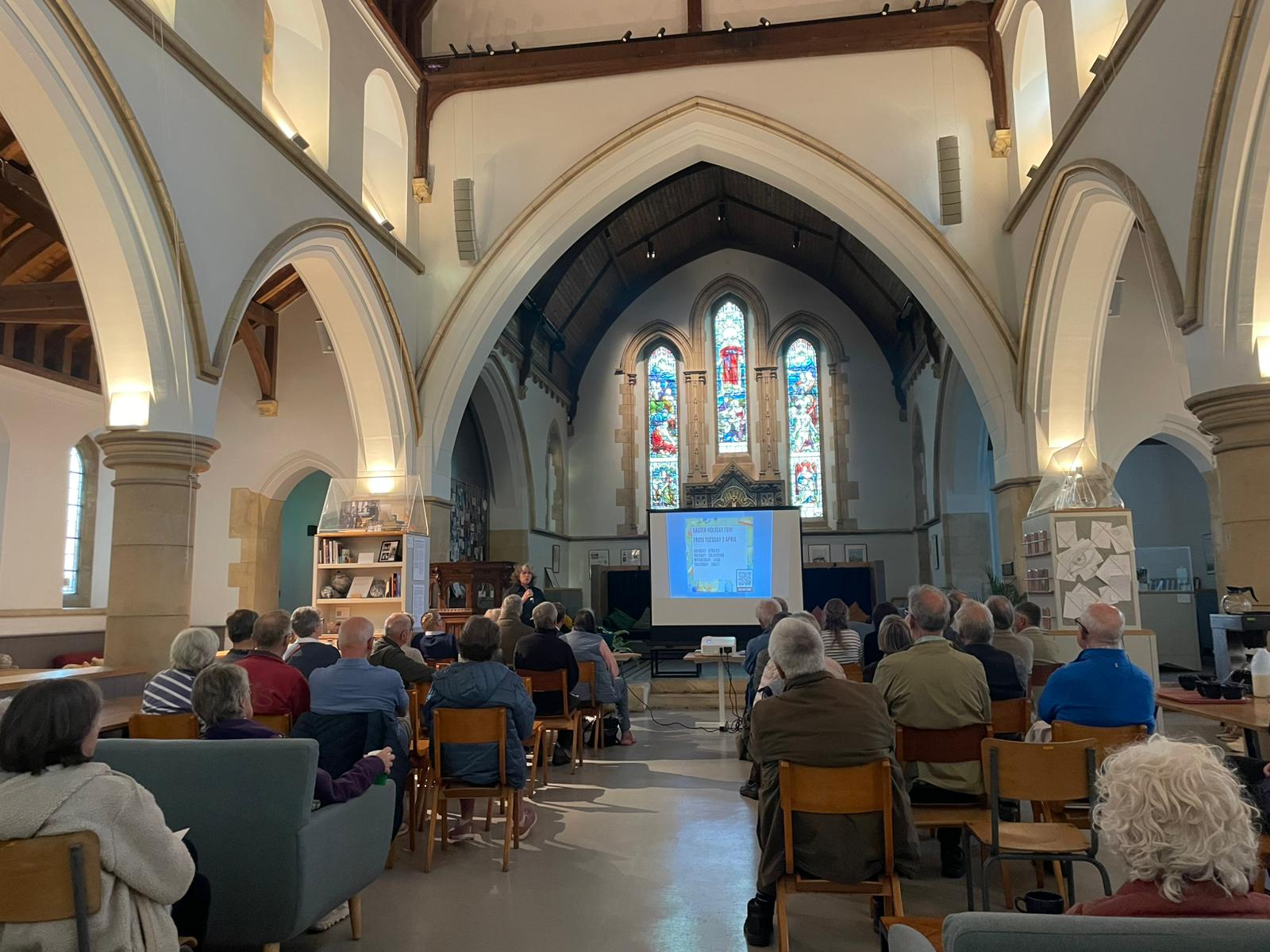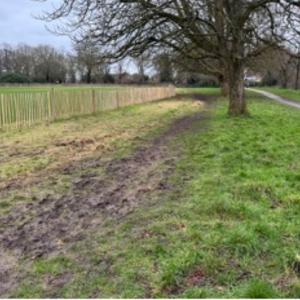Thursday 9 October 2025 at 5:00pm at Graylingwell Chapel
| Welcome and Introductions and apologies for absence. The Chair welcomed everyone to the meeting and set out the purpose of the Annual General Meeting for the Trust. Apologies from Nicky Dodd |
| Minutes of the AGM held Wednesday 16 October 2024 The minutes of the AGM were presented and agreed as a true record. |
| Chair’s Statement 2024.2025 The Chair, Sue James summarised her statement outlining the progress and achievements of CCDT over the year of 2024 to 2025. Thanks were given to staff and volunteers for their effort A challenging but successful year saw CCDT acquire the Marchwell Studios site, secure National Lottery Heritage funding, and raise over £100,000 for the community cycle workshop. Volunteers received the King’s Award, and we didn’t know but it was the last year with Clare de Bathe as CEO. |
| Presentation on CCDT’s work 2024.25 CEO Liz Woodsell presented details of achievements throughout the past year, and the strategy for the future. CCDT has grown into a sustainable, community-rooted organisation managing 14 assets. Thanks were given to Clare de Bathe, trustees, staff, and volunteers—recognised with The King’s Award. Work continues on Marchwell Studios and plans progress for the Red Brick Pavilion. CCDT remains focused on its five-year strategy to strengthen communities, expand facilities, and achieve carbon neutrality. |
| Receipt of Annual Report and Financial Statements for the year to 31 March 2025 CCDT’s treasurer, John Eagles, put forward the accounts for approval 1 April 2024 to 31 March 2025. He provided insights into the past year’s accounts, raising attention to key findings, primarily that the majority of income is restricted to refurbish Marchwell Studios and presented the accounts to the AGM. He showed analysis of The Chapel and The Pavilion which generated a small profit and Havenstoke Park which runs at a loss. |
| Appointment of trustees and re-elections Sue James and John Eagles were reappointed Sophie Hamnett and Tony Cross were appointed Noted that Peter Day has resigned and Liz Woodsell has replaced Clare de Bathe as Company Secretary |
| Appointment of Blue Spire as auditors of the Trust Blue Spire based in Chichester; West Sussex were proposed by the treasurer as the accountants and auditors of the CCDT. This was seconded by the chair, and all voted in favour of working and appointing Blue Spire as Auditors for 2025.2026 |
| Questions Request for minutes – will be on website by 16 October 2025 Date of AGM 2026 – dependent on Financial Audit, but will be October 2026 Residents Levy – see separate sheet Location of Community Garden – unable to change as part of original planning application |
| Close of AGM There was no other business, and the AGM closed at 6:15pm |
Response to questions about Resident’s Levy Context: Jonathan Brown’s experience as a councillor, particularly with regards seeing what happens on newbuild developments, made him the obvious person to answer the six questions relating to the Resident Levy.
1) Please clarify who pays the Resident Levy.
All residents of Graylingwell.
- Owner/occupiers directly through Grange.
- Housing Association tenants through Clarion.
- Private renters pay via their rent (their landlords actually pay the levy).
2) Please clarify who is able to benefit from the Trust’s work. As it “is essential to continue delivering services”, are these services restricted to those paying the Resident Levy?
In short: anyone.
Note: there is a “Community Use” qualification. i.e. CCDT has a mission: “To own and manage community buildings and lands, safeguarding these important spaces for community use in perpetuity” which provides direction. (So “anyone” is anyone who would benefit from CCDT’s mission.)
No services are restricted to those paying Resident Levy.
This is where it’s useful to compare what happens in Graylingwell with other new estates.
There is a principle which has been operating nationally for many, many years. Not a good one, but it has been in place for a long time.
i.e. New development pays for services that are used by everyone. Public realm / spaces that most people (myself included) feel ought to be covered by Council Tax, and which many years ago would have been covered by Council Tax, is now paid for by residents of new estates through service charges. E.g. the country park at Minerva Heights; the path through Lavant View down to Madgwick Park, etc. These sorts of things are always now paid for out of service charges paid by residents of those new estates.
There is an assumption that new residents may benefit disproportionately, but there is no requirement that they do so. Indeed, the new amenities are specifically for the use of the whole community.
What makes Graylingwell Park different is that, in effect, our charge is split into two: the ‘standard’ Service Charge and the additional Resident Levy which goes to CCDT.
However, CCDT operates many of the amenities that in any other newbuild estate would be funded from the service charge e.g. Havenstoke Park. If CCDT had never existed, the two sets of charges would have been a single, combined i.e. larger, service charge. The costs covered by the Levy wouldn’t disappear, they’d have been merged with the regular service charge.
The reason CCDT is separated out from the service charge is to enable CCDT to carry out a far greater range of activities (and to operate more assets) than would otherwise be possible AND to enable it to carry out a range of activities which generate additional income.
This enables the running of amenities very different to most new developments – like the Chapel – AND this additional income subsidises the costs that would otherwise be born by residents. i.e. If CCDT didn’t exist and the two charges were combined, the result wouldn’t just be the total of the two charges, it would be greater than the two charges combined.
3) Is the Trust expected to become self-financing so that at some stage the Resident Levy will be eliminated?
The Resident Levy is already only a very small part of Trust’s income. An important one, but a small one. All sources combined, the Trust is already self-financing – although to be clear that does include the levy.
(As you will have heard earlier this evening, this also takes into account a lot of commercial work undertaken by the Trust and the efficiency savings including redundancies that have been made this year.)
The Board will consider this question, but…
For the avoidance of any doubt, the expectation should be that for the foreseeable future the Resident Levy won’t be eliminated or reduced.
- (Development at Graylingwell Park is expected to continue for at least several more years, so there are still more levy-paying residents and income-generating assets to be delivered.)
If it becomes possible, we are talking it being years away from being able to do that. Residents should expect an inflationary rise in the cost of the levy for the foreseeable future.
Although the levy is only small part of CCDT’s funding it is important: it does create accountability to the community in which CCDT is based.
4) How was the size of the Resident Levy initially decided and how has it been adjusted in subsequent years?
CCDT was set up as per a s106 (planning obligation) which required the levy to be set in compliance with the original business plan for the trust, which set it at £50p/a. That’s how it was initially decided.
It’s never been increased until now as there was no requirement to do so. A fuller explanation was set out in the letter that went to residents but the gist of it is:
- For many years interest rates were very low. There was no need to raise income.
- Covid and the years that followed saw a huge surge in inflation & cost of living crisis.
- In common with other organisations, the decision was made not to pass on costs while everyone struggling.
- After doing that for several years it got to the point where a rise couldn’t be deferred any longer.
- This rise was implemented alongside redundancies and taking on additional business / income streams. i.e. The rise in the levy was not only used to close the gap.
- The intention is for it to raise in line w/ inflation each year from now on, so that residents know what to expect.
The Levy has never been the ‘first port of call’ for any new need for income and it won’t be. The Trust is very aware of the importance of the link with the community and the sensitivity of the fact that the levy is only paid by residents.
N.B. It was clarified at the meeting that the rise was to £75 although if it had been raised every year in line with inflation it would be in the region of £120 now.
5) Is there a risk that future delays in the delivery of income generating assets or such assets failing to generate expected income could leave the Resident Levy having to fill the gap?
The maximum that the Resident Levy can be included is in line with RPI, so the Trust couldn’t and wouldn’t be able to raise enough through the levy to offset something like the loss of an asset expected to raise £100,000s p/a.
It simply couldn’t be done.
It’s worth reiterating that the Trust has faced financial challenges for many years. Most notably, the receipt of loss-making assets not matched by income-generating assets, but has always managed to make things work. The levy remains only a small part of the trust’s income.
6) Are the currently delivered income generating assets generating the incomes expected of them?
The business plan has always been for income generating assets to cover the costs of loss-making ones.
CCDT has received loss-making ones in advance of income-generating ones – so a lot of commercial activity has been needed to fill the gap.
It is still the expectation that when everything delivered – which won’t be for several years – income-generating assets will cover loss-making ones.
As of today, loss-making assets outweigh income-making ones, and this has been the case for years. But…
- Income-generation from the income-generating assets is broadly as expected.
- Losses from loss-making assets are also as expected.
Does need to be flagged that ‘unknown unknowns’ are always a possibility. Sometimes you get lucky, and something that goes well will bring in more than anticipated. Sometimes there are unanticipated costs (e.g. the cleaning up of Havenstoke Park after travellers). This is true of all organisations – it’s not a problem unique to CCDT – but it is an important caveat.




